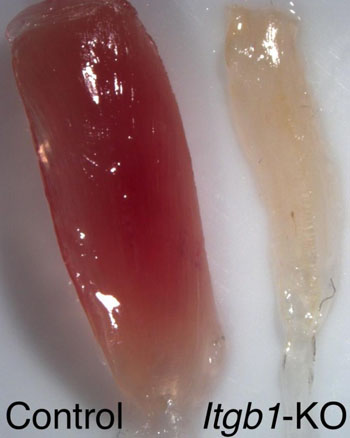Age-Related Lack of Attachment Proteins Diminishes Regenerative Ability of Muscle Tissue
By LabMedica International staff writers
Posted on 20 Jul 2016
The cellular attachment proteins fibronectin and beta1-integrin have been linked to age-related changes that limit the ability of muscle tissue to regenerate and in the reduced maintenance of muscle stem cells.Posted on 20 Jul 2016
Integrins are transmembrane receptors that mediate the attachment between a cell and the tissues that surround it, such as other cells or the extracellular matrix (ECM). Fibronectin is a high-molecular weight ECM glycoprotein that binds to attachment proteins such as integrins. Similar to integrins, fibronectin binds extracellular matrix components such as collagen, fibrin, and heparin sulfate proteoglycans.

Image: A normal muscle (left) is compared to a muscle lacking beta1-integrin (right) (Photo courtesy of Chen-Ming Fan, Michelle Rozo / Carnegie Institution for Science).
Investigators at the Carnegie Institution for Science (Baltimore, MD, USA) and colleagues at the École Polytechnique Fédérale de Lausanne (Switzerland) combined efforts to study the molecular basis for the detrimental effects of aging on muscle tissue.
They reported in two papers published in the July 4, 2016, online edition of the journal Nature Medicine that there was a strong link between the action of beta1-integrin and fibronectin in the deterioration of muscle during aging. Beta1-integrin was found to be diminished in aged muscle stem cells (MuSCs). Artificial removal of beta1-integrin from youthful muscles caused them to behave as if they were old, while activation of beta1-integrin in mice with aged muscles restored their regenerative abilities to youthful levels.
Similarly, the aged stem cell niche in skeletal muscle contained substantially reduced levels of fibronectin (FN), leading to detrimental consequences for the function and maintenance of MuSCs. Deletion of the gene encoding FN from young regenerating muscles replicated the aging phenotype and led to a loss of MuSC numbers. Reconstitution of FN levels in the aged niche remobilized stem cells and restored youth-like muscle regeneration. Improvement in regeneration, strength, and function were also seen when this treatment was applied to animals with muscular dystrophy.
"Inefficient muscular healing in the elderly is a significant clinical problem and therapeutic approaches are much needed, especially given the aging population-and, I am including myself in this population," said senior author Dr. Chen-Ming Fan, researcher in the department of embryology at the Carnegie Institution for Science. "Finding a way to target muscle stem cells could greatly improve muscle renewal in older individuals. Taken together, our results show that aged muscle stem cells with compromised beta1-integrin activity and aged muscles with insufficient amount of fibronectin are both root causes of muscle aging. This makes beta1-integrin and fibronectin very promising therapeutic targets."
Related Links:
Carnegie Institution for Science
École Polytechnique Fédérale de Lausanne














